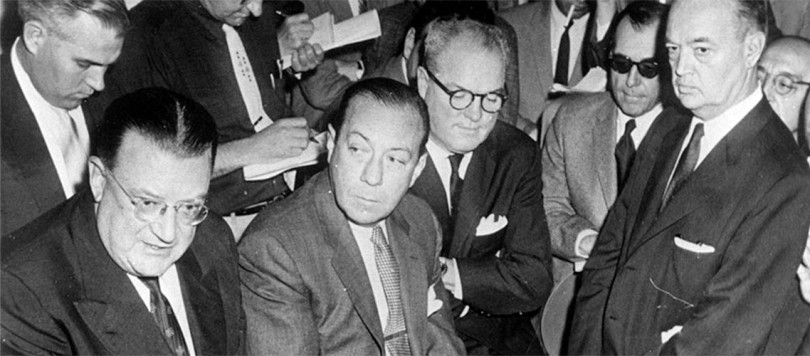
Reference Biography: Walter O’Malley
1957 - Part 2
On May 28, 1957, the National League, meeting in Chicago, granted the New York Giants and the Dodgers permission to move to San Francisco and Los Angeles, respectively, if the two clubs would shift together before October 1, 1957. The next day, New York Mayor Wagner requested a meeting with O’Malley and Giants’ owner Horace Stoneham. The meeting was held on June 4 and O’Malley and Stoneham made it clear that they were neither committed to stay in New York or move to the West Coast. Stoneham had originally wanted to move to Minneapolis-St. Paul, site of his Triple-A affiliate, and pay a territorial fee to disband the minor league team, but O’Malley and others suggested that he consider burgeoning San Francisco as a new locale for the Giants. This way, costly travel expenses for all other National League clubs would be more economical, plus the longtime rivalry could be maintained.
In testimony before the House Antitrust Subcommittee of the Committee of the Judiciary in Washington, D.C. before Chairman Hon. Emanuel Celler on June 26, 1957, O’Malley was asked repeatedly whether the Dodgers were going to play baseball in Los Angeles in 1958. O’Malley’s response: “I do not know the answer for two reasons. One, I do not know what the result of Mayor Wagner’s study in New York City will bring. Two, I do not know whether or not Los Angeles will be ready for major league baseball next spring.”
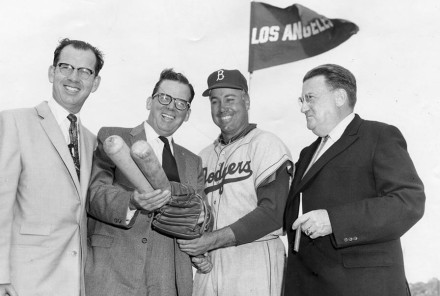
Los Angeles County Supervisor Kenneth Hahn, L.A. Mayor Norris Poulson, center fielder Duke Snider and Dodger President Walter O’Malley at Dodgertown in Vero Beach, FL on March 6, 1957. Los Angeles made a pitch to O’Malley in discussions there.
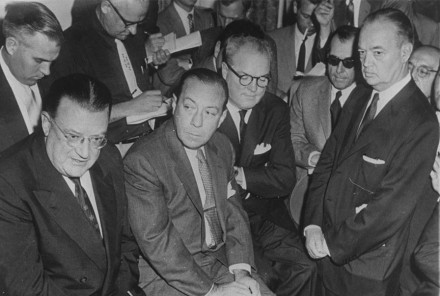
On June 4, 1957, Walter O’Malley appears at a press conference along with (front L-R) New York Mayor Robert Wagner, New York Giants President Horace Stoneham and Brooklyn Borough President John Cashmore.
AP Photo
Responding to charges that O’Malley was playing New York against Los Angeles for the purposes of going to the highest bidder, he explained, “It is a very simple situation, Mr. Chairman. I started out in 1947 trying to get a new ball park for the Brooklyn Dodgers in Brooklyn. We hired an engineer, we conferred with our civic officials, and made very serious studies of various sites.
“It developed that at that time the way could not be found to condemn land to assemble a plot large enough, and, of course, the ball club very properly does not have the legal right to condemn land. But it was hoped that there was enough of a public purpose in the activities surrounding a ball club, particularly if it could be tied in with other things of civic importance such as the relocation of a meat market. The meat market men said that if they were relocated, they could bring the price of meat down 5 cents a pound in Brooklyn. That seemed to be a pretty good civic proposition. There was a traffic intersection of Atlantic and Flatbush which is a very bad one, and some day it is going to be cured.
“That, too, becomes part of a civic purpose in trying to assemble the land at Atlantic and Flatbush. Then there is a question of parking in that area of our community where our department stores are located. Some parking facilities were needed in that area. There was also the observation that the property for the most part was substandard, and had been so designated by Mr. Moses as subject to a study for slum clearance.
“Then we had a railroad station at that project, an old-fashioned, real old country depot that also was dirty and improperly planned, and when the Long Island Railroad came out of bankruptcy, part of the agreement under the Railroad Redevelopment Act passed by the Legislature of New York provided that the railroad would have to purchase, I believe it was, $200 million worth of modern rolling stock and put on that railroad.
“At the time I presented this site for consideration, none of that new equipment, which was then on the tracks of the railroad, could come into Brooklyn, and those of us in Brooklyn were embarrassed because, if you wanted to get into a modern car, an air-conditioned car, you had to go to Manhattan, which meant that women coming in from the island to do their shopping in the summer months would not come in, in the old Camp Yaphank troop trains into Brooklyn when they could get a modern air-conditioned car right into the shopping center of Manhattan.
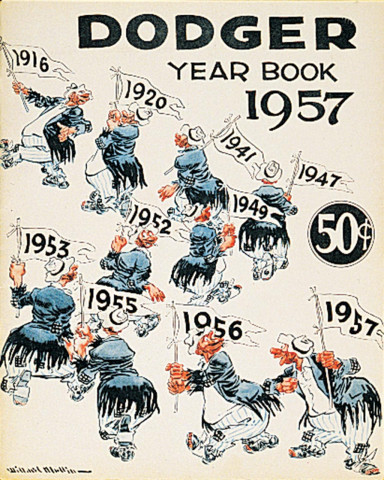
Although the Brooklyn Bum character dreamed of a ninth National League pennant in 1957, the Dodgers weren’t contenders during their final season in New York.
Copyright © Los Angeles Dodgers, Inc.
“This plan would have provided for track curvatures so that the new railroad equipment could come into Brooklyn. We then would have had a railroad depot that we could have been proud of in Brooklyn. We would have relocated our meat market. We would have had parking facilities. We would have cleared up a traffic intersection that was terrible. And all of this would have magically left enough acres of land on which a ball park could be built, at the cost of the owners of the Brooklyn Ball Club, not one penny of which was to be paid by the city of New York. I think that is very important to know.” Verbatim Transcript of House Antitrust Subcommittee of the Committee Judiciary before Chairman Emanuel Celler, June 26, 1957
In its “Study of Finances Required for Brooklyn Stadium” report of August 5, 1957, consulting engineers for the Brooklyn Sports Center Authority Madigan-Hyland concluded that a domed stadium would run an estimated $12,502,000 and approximately $3 million less without the dome. “The stadium should be considered as a general-purpose facility which would be of wide service, not only as a major league ball park, but also as the site for staging other events. The principal use of the stadium is to serve as a home for the Brooklyn Dodgers. Since there are only about seventy days a year when the stadium would be used for Dodgers events, the facility is available for other uses during most of the year.
“The stadium would be ideally suited for football, basketball, boxing, tennis and various types of track events. While the present preliminary design and cost estimates have not made allowances for it, the stadium also could be equipped for use by ice events; ice hockey, ice shows and public skating. The stadium would also be available for revenue-producing events outside of the field of sports.” “Study of Finances Required for Brooklyn Stadium,” report by Madigan-Hyland consulting engineers, August 5, 1957
In July 1957, sensing that the negotiations needed to be spearheaded for the City and the County speaking with one voice, Los Angeles Mayor Poulson tabbed Harold “Chad” McClellan, who formerly served as Under-Secretary of Commerce for International Affairs in the Department of Commerce in the Eisenhower Administration, to begin formal discussions with the Dodgers and O’Malley. McClellan recalls the events that led to his first meeting with O’Malley in Brooklyn on August 21, 1957.
“Prior to my enlistment as negotiator for our City and County, two significant conferences had taken place,” he wrote in 1963. “The first was a meeting at Vero Beach, Florida with Mr. O’Malley, Mr. Dick Walsh and other Dodger officials. This meeting was attended by Supervisor Kenneth Hahn, Mr. Milton Arthur and Mr. John Leach representing the County and by then Mayor Norris Poulson, Councilman John Gibson and City Administrator Samuel Leask representing the City. The meeting got considerable publicity. The purpose, I was later instructed, was to get the Dodgers — if we could. No final conclusions were agreed upon.
“The second significant conference took place at the Statler Hotel here in Los Angeles on May 3, 1957. This second meeting, which included representatives from both City and County, resulted in what later became known as the Arnebergh Memorandum. This Memorandum represented the thinking of those in attendance as to what should be offered the Dodgers. At least this was the instruction given me two months later (early July, 1957) when I moved into Room 189 of the City Hall and went to work. The “Arnebergh Memorandum” was handed me as my basic guide in negotiations. Here it is:
The Arnebergh Memorandum
May 3, 1957
At a conference today, held at the Statler Hotel, discussion was had involving the possibility of bringing Major League Baseball to Los Angeles. It was indicated that the City and County should be prepared to make an offer containing the following provisions:
City and/or County to acquire and deed to the Major League Baseball club 350 acres in Chavez Ravine, including the present 257 acres now owned by the City, the additional acreage to be adjacent thereto. Such 350 acres to comprise an approximate circle, if possible.
City and/or County to provide access roads.
City and/or County to superficially pave parking roads.
City to accept dedication of circumferential roads.
The 350 acres, together with improvements, etc., to go on tax rolls.
There should be no deed restrictions on use of such 350 acres except that a modern major league stadium will be built and Major League Baseball brought to Los Angeles.
Major League Baseball club, at its sole cost and expense, to build modern baseball stadium and bring major league team to Los Angeles.
Wrigley Field to be deeded to City and/or County in present condition as partial consideration for said 350 acres, with restriction against Major League Baseball being played in Wrigley Field.
Major League Baseball club, as further consideration for said 350 acres, will agree to construct, maintain and make available to the public, free of charge, various recreational facilities such as tennis courts, junior league baseball field, basketball courts, etc., these to be more specifically determined later.
As further consideration for said 350 acres, Major League Baseball club to agree to admit, at specified times, juveniles to ball games free, as an aid to the City and County in combating juvenile delinquency, etc.
“There was another circumstance in 1957 of which we should all be mindful,” McClellan continued. “It would be difficult to overstate the zeal with which our City and County officials generally were then possessed, and their enthusiasm for the effort was shared widely through the community. Nor were Mr. O’Malley’s expectations for an attractive offer by the City discouraged by the conferences held with him prior to my entering the picture. Quite the contrary. I recall that during the early days of my work, while I was still searching out the facts on such matters as acreage available in the Ravine area, topography, zoning problems, deed restrictions and other items, and before I felt well enough informed with solid facts to start actual negotiations, a member of the City Council took me sharply to task in a radio news cast for ‘needless delay’ — promising to seek my removal as city representative if I didn’t go to New York at once and show more speed of action.
“When I joined the effort to bring the Dodgers here, no final determination had been made as to where a stadium would or could be built. Chavez Ravine was O’Malley’s choice I was told, if the Dodgers moved here, but other sites were to be considered as well. The main issue then was — not to get a stadium, but to get a first rate Major League Ball Club. It was recognized too, that a ball club is essentially a community institution — an organization of talented, colorful, skilful[sic] athletes — not merely a facility made up of land, bricks and mortar with a price tag on it. Our thinking was — without the Dodgers in it, any stadium — wherever built, at whatever cost would be of doubtful value to this community. Furthermore, we knew that any second rate, faltering club in Southern California would be more of a liability than an asset. People simply wouldn’t go to the games. It was the Dodgers we wanted. The prime issue then was — how to get the club to come. Consequently, the urgency imposed upon me by the officials to negotiate with speed, skill and some latitude was heavy indeed; not once however, did I exceed or violate instruction given me. No commitment was ever made by me without prior, specific authorization.
“My first meeting with Walter O’Malley took place on the morning of August 21, 1957 in Brooklyn, New York. By this time I was well prepared. I had benefited by numerous conferences with members of the City Council, members of the Board of Supervisors and with Mayor Norris Poulson. I had in addition obtained a great many of the essential facts.
“My first meeting with Walter O’Malley lasted all day. It was evident at once that while he knew all about the arrangements between other ball clubs and the cities where they were located, he wanted a completely different arrangement with Los Angeles if he moved here. Mr. O’Malley declared that he wanted to build his own stadium with Dodger financing. He was determined to make his club’s stadium the most modern, the most imaginative ever built. He told me he had dreamed of this for years — that he already had a model built, even though he had not yet decided where to build it, or when. (Mr. O’Malley, Captain Praeger and I spent some time during the afternoon studying the model together in relation to the Chavez Ravine property; I had a map with me.)
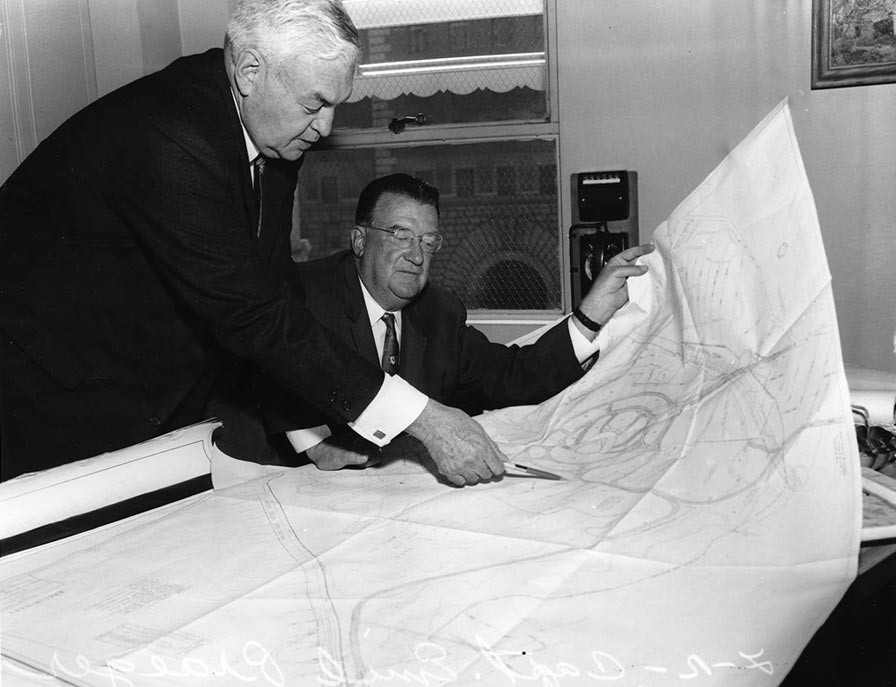
Captain Emil Praeger and Dodger President Walter O’Malley worked together for more than a decade, designing and planning potential sites for the Dodgers’ new ballpark. Capt. Praeger and O’Malley also designed Holman Stadium in Vero Beach, FL in the early 1950s.
Courtesy of University of Southern California, on behalf of the USC Specialized Libraries and Archival Collections
“Many questions were discussed in this first meeting I had with O’Malley. No commitments were made, but several points were made clear to him:
Contrary to impressions earlier given, a maximum of 306 or 307 acres could be made available at reasonable price in Chavez Ravine. Three hundred fifty acres were not available.
A City reservoir on the property — (within the area needed) must remain. Nor could the reservoir be moved or lowered. We must work around it or abandon the Ravine as a possible site.
Any plan contemplating land ownership by the Dodgers Corporation must be developed on a legitimate buy and sell basis with values established fairly, in good conscience. There would be no free gifts or subsidy. We did not at this time discuss specific terms of a possible agreement. It would have been premature.
“Many weeks of discussions and negotiations followed, various possibilities were considered. Questions were raised and answered. Throughout this period, I worked closely with Samuel Leask, the Mayor and County Officials.
“On September 16, 1957, at my suggestion, the City Council of Los Angeles adopted a resolution giving me authority to make a specific proposal to the Dodgers (substantially, the terms as are now in the contract).” “The Truth About the Dodgers” by Chad McClellan, August 9, 1963
On August 26, 1957, the Dodgers issued an announcement stating in part: “The recent announcement (on August 19) that the Giants are leaving New York City has produced renewed interest in the Dodger problem here and abroad...Locally, the Dodgers are on the record as offering to build their own stadium with their own money at Atlantic & Flatbush Avenues if the land can be made available promptly and at common sense figures. For over a year the Dodgers have had a standing offer to put $5,000,000 in a new stadium to pay $500,000 annual rental plus 5% of gross admissions as a New York City amusement tax. If all efforts fail locally the Dodgers could buy the necessary land in Los Angeles on which to build their own stadium, which would be on the tax rolls. The same program has been offered to New York City where the Dodgers only need the help of the city in condemning the land.”
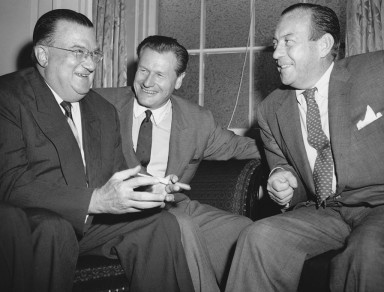
(L-R) Walter O’Malley, Nelson Rockefeller and New York Mayor Robert Wagner in 11th hour discussions at Gracie Mansion in New York in September 1957.
AP Photo
As the 1957 season wound to a conclusion, Brooklynites were becoming increasingly saddened that the tide had indeed turned to Los Angeles and they were about to lose a team that had meant so much to the fabric of their society. But, it was not the only factor that would leave Brooklyn, almost as fast as the populous. The famous Coney Island beachfront attraction was fading in popularity and the city’s neighborhoods and demographics were rapidly changing. The Brooklyn Eagle newspaper had folded and some 70,000 employees who had worked at the failed Brooklyn Navy Yard were looking for work, changing the look and feel of the city. Daily News, New York, Pete Hamill column, August 10, 1979 The Long Island Railroad Station at Atlantic and Flatbush Avenues needed to move to the opposite side of the street in order to straighten the tracks so that new up-to-date trains could run into Brooklyn and provide better service according to Commissioner Moses. Memo from Robert Moses to Mayor Robert F. Wagner, December 7, 1956 The loss of “Dem Bums” was one more disappointment to their city’s changes, and understandably a hard one for Brooklynites to swallow, along with the others, but O’Malley made the difficult decision that could be made under the circumstances left him by local politicians and appointed officials.
At the 11th hour, financier-philanthropist Nelson Rockefeller made a last-ditch financial aid proposal to keep the Dodgers in Brooklyn, which apparently was more of a grandstanding move than one that drew any real interest from New York City officials or O’Malley. By that point in mid-September 1957, the script was almost complete for a move west. However, O’Malley would not make any commitments to Los Angeles until the Board of Estimate had heard Rockefeller’s plan.
Rockefeller originally planned to purchase for $1.5 million the property that the city would then condemn in downtown Brooklyn. Madigan and Hyland engineering firm had placed the cost of condemning the land at $8 million. Later, Rockefeller’s offer grew to $2 million. In effect, the $2 million would be a loan to the Dodgers with interest and the acquisition of 12 acres in order to build a stadium. Rockefeller called his offer “a realistic reflection of today’s real estate values” and “a basis for permanent improvements which would increase values in the entire area and add to the city’s tax revenues so as to offset a temporary loss to the city in the price of the land.” New York Post, William H. Rudy, September 20, 1957
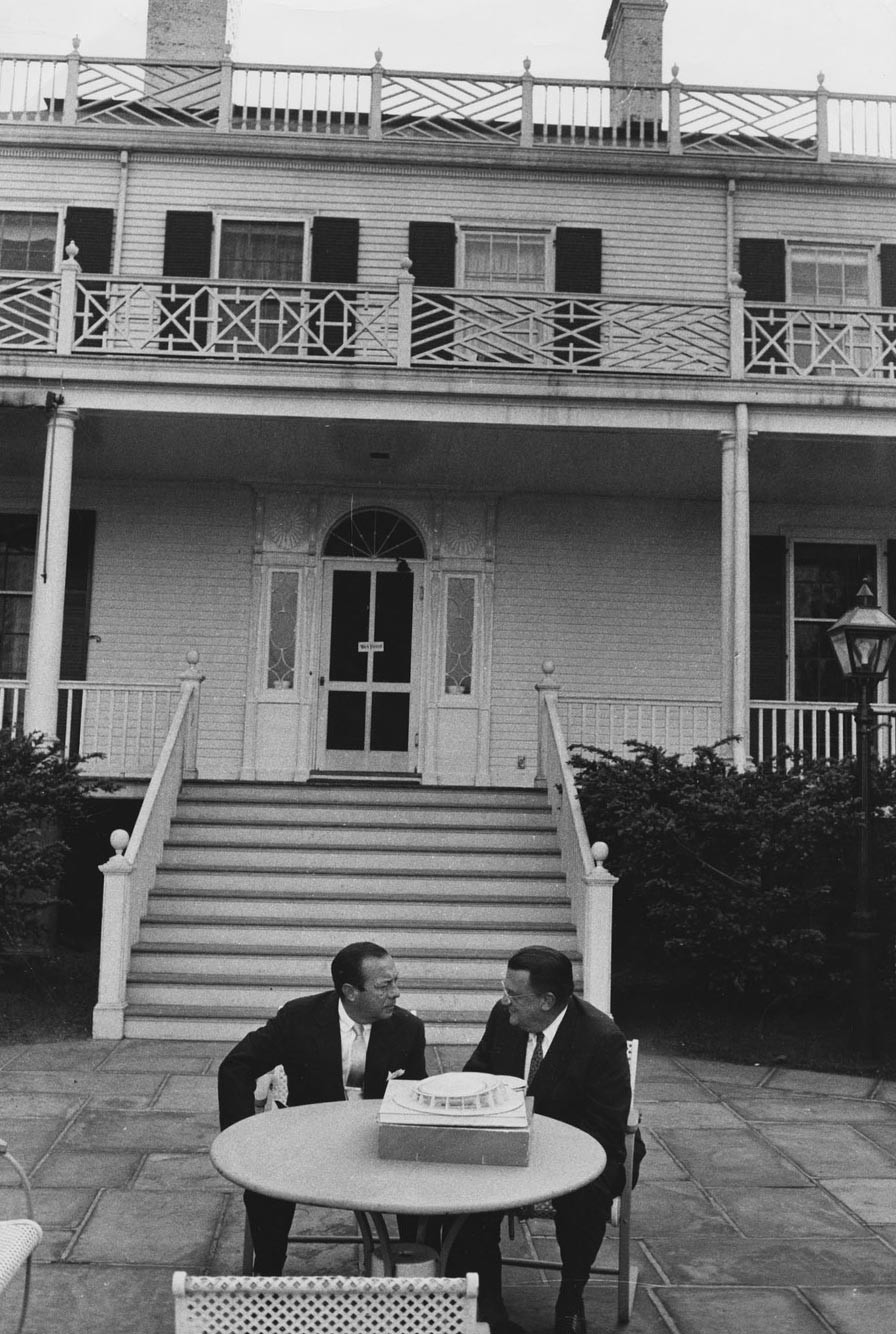
Walter O’Malley (right) with New York Mayor Robert Wagner and a model of the proposed domed stadium for the Dodgers, delayed the Dodgers’ decision until an emergency meeting of New York’s Board of Estimate was held in September 1957.
Copyright © Los Angeles Dodgers, Inc.
Rockefeller met at City Hall with Mayor Wagner and Goodfellow, president of the Long Island Rail Road, to discuss the proposed Atlantic and Flatbush site for the new stadium. Rockefeller commented that the Dodgers were willing to invest their own money for a stadium and that the city’s right to condemn the necessary land for slum clearance and re-sell it had been confirmed by Corporation Counsel Brown. In the meantime, a guarded O’Malley was weighing his attractive Los Angeles offer against the New York plan, which was not well-received by many. O’Malley stated, “If we are to stay, we must not only receive the site that is best suited for our purpose, but we must also be given terms that are most reasonable and fair.” Long Island Press, Joe Reichler, September 11, 1957 City Controller Lawrence Gerosa, a longtime opponent of any stadium proposal, called it a “giveaway” of taxpayers’ money. New York Post, William H. Rudy, September 20, 1957
Rockefeller then upped his bid to $3 million, but the Board of Estimate did not reach a decision during a three-and-a-half hour special meeting. Rockefeller would lease the land back to the Dodgers for 20 years. Then, if O’Malley did not purchase the land, it would be repurchased by the city at the price that Rockefeller had paid. An emergency board meeting had been held, after O’Malley, Mayor Wagner and Rockefeller met at Gracie Mansion, with O’Malley agreeing to delay any action in Los Angeles until the board could be consulted. New York Daily News, Dominick Peluso and Harry Schlegel, September 19, 1957

